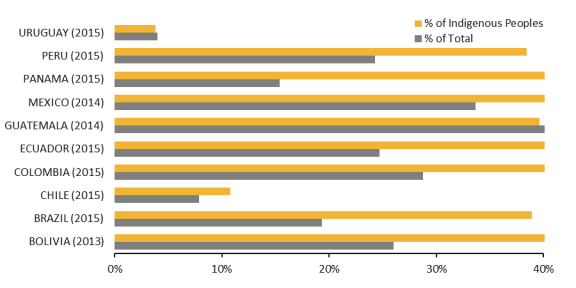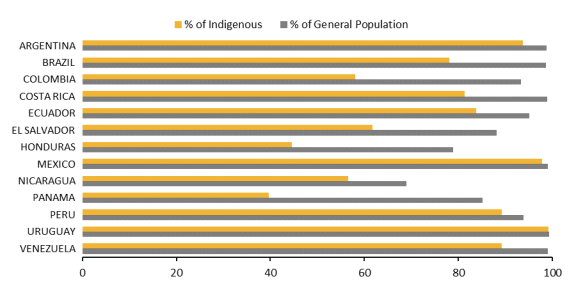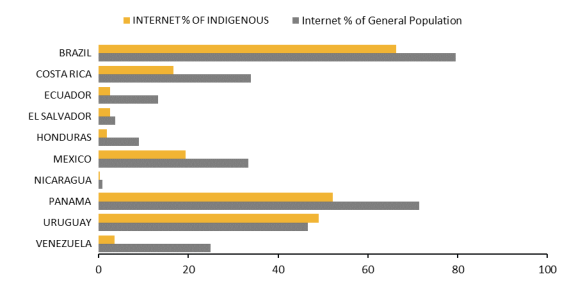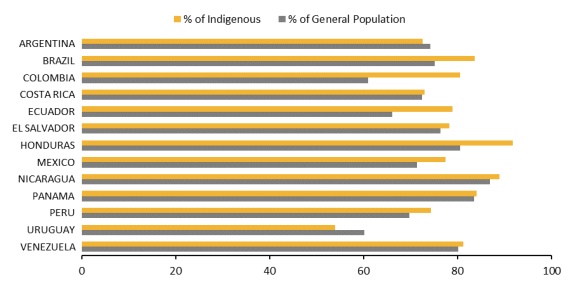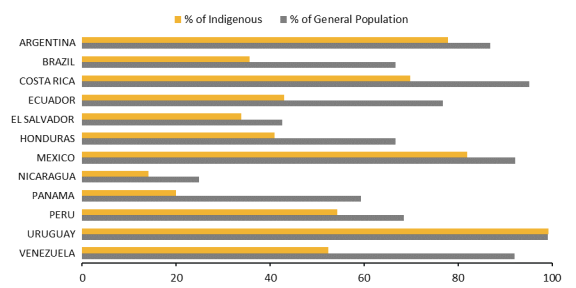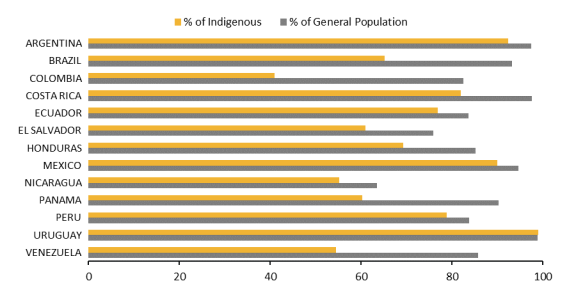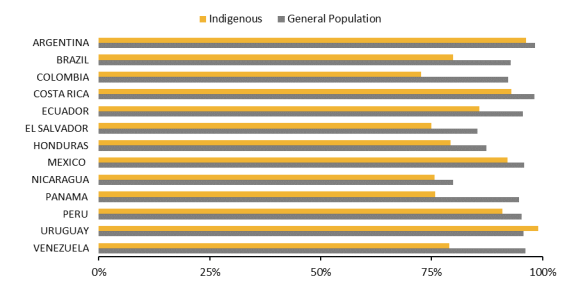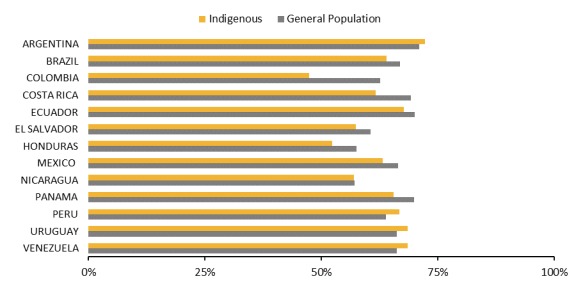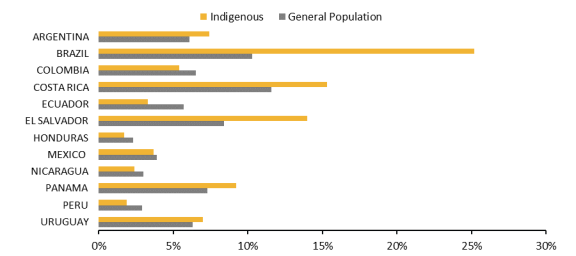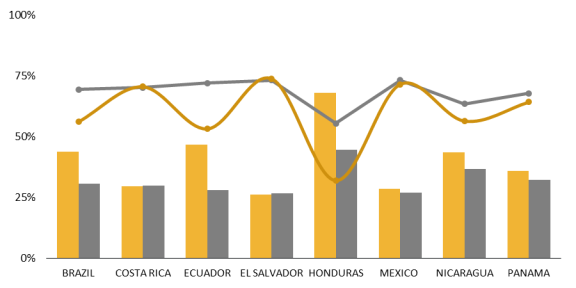Indigenous Peoples in Latin America: Statistical Information
Changes from February 13, 2020 to July 16, 2020
This page shows textual changes in the document between the two versions indicated in the dates above. Textual matter removed in the later version is indicated with red strikethrough and textual matter added in the later version is indicated with blue.
Indigenous Peoples in Latin America: Statistical Information
Contents
Figures
- Figure 1. Total Indigenous Population and Percentage of General Population of Latin America
- Figure 2. Indigenous Population in Latin America as Percentage of General Population by Country
- Figure 3. Total Number of Indigenous Groups in Latin America
- Figure 4. Total Number of Indigenous Languages in Latin America
- Figure 5. Rates of Indigenous People Living on Less than $5.50 a Day in Select Latin American Countries
- Figure 6. Electricity Access Rates in Select Latin American Countries (2018)
- Figure 7. Internet Access Rates in Select Latin American Countries (2018)
- Indigenous Peoples in Latin America: Statistical July 16, 2020
Information
Carla Y. Davis-Castro
This report provides statistical information on indigenous peoples in Latin America. Data and
Research Librarian
findings vary, sometimes greatly, on all topics covered in this report, including populations and
languages, socioeconomic data, land and natural resources, human rights and international legal conventions. For example, Figure 1, shows three estimates for the indigenous population of Latin
America. These estimates range from UNICEF’s 2009 estimate of the total indigenous population of Latin America of 29.4 million; to the Economic Commission for Latin America and the Caribbean’s (ECLAC’s) 2014 estimate of 44.7 million; to the World Bank’s (WB’s) 2015 estimate of 41.8 million (7.85% of the population).
Total Indigenous Population and Percentage of General Population of Latin America
Source: Graphic created by CRS using UNICEF and FUNPROEIB Andes’ (UNICEF) 2009 Atlas Sociolingüístico de Pueblos Indígenas en América Latina; the International Bank for Reconstruction and Development and World Bank’s (WB) 2015 Indigenous Latin America in the twenty-first century: the first decade; and the Economic Commission for Latin America and the Caribbean’s (ECLAC) 2014 Guaranteeing indigenous people’s rights in Latin America: Progress in the past decade and remaining challenges. Notes: The ECLAC report includes a table titled “Latin America (17 countries): population of indigenous peoples according to censuses and estimates, around 2010.” The World Bank report uses national censuses to provide demographic information and notes “for countries without census data available for the end of the decade, the indigenous population was estimated by applying the percentage of the last census to the 2010 projection of the national population.
Definitions of indigenous peoples also vary. The United Nations and many countries rely on self-identification of indigenous peoples. In counting distinct groups, this report uses the term “indigenous groups” rather than “tribe,” “nation,” “ethnic minority,” or “sociolinguistic group.”
Resource lists for each section (languages; socioeconomics; land, natural resources, and climate change; international organizations; and human rights) are available in the appendix as well as a lists of national agencies that oversee indigenous affairs in each Central American or South American country.
Congressional Research Service
link to page 5 link to page 5 link to page 6 link to page 11 link to page 14 link to page 21 link to page 22 link to page 23 link to page 7 link to page 7 link to page 10 link to page 10 link to page 12 link to page 12 link to page 15 link to page 15 link to page 16 link to page 16 link to page 17 link to page 17 link to page 18 link to page 19 link to page 19 link to page 20 link to page 20 link to page 20 link to page 8 link to page 8 link to page 13 link to page 24 link to page 25 link to page 25 link to page 28 Indigenous Peoples in Latin America: Statistical Information
Contents
Introduction ..................................................................................................................................... 1
Terms ......................................................................................................................................... 1
Population Data ............................................................................................................................... 2
Indigenous Groups and Languages ........................................................................................... 7
Socioeconomic Data ...................................................................................................................... 10 Land and Natural Resources .......................................................................................................... 17
Climate Change ....................................................................................................................... 18
Human Rights and Multilateral Instruments ................................................................................. 19
Figures Figure 1. Total Indigenous Population and Percentage of General Population of Latin
America ........................................................................................................................................ 3
Figure 2. Indigenous Population in Latin America as Percentage of General Population by
Country ......................................................................................................................................... 6
Figure 3. Total Number of Indigenous Groups in Latin America .................................................... 8 Figure 4. Total Number of Indigenous Languages in Latin America .............................................. 8 Figure 5. Rates of Indigenous People Living on Less than $5.50 a Day in Select Latin
American Countries ..................................................................................................................... 11
Figure 6. Electricity Access Rates in Select Latin American Countries (2018) ............................ 12 Figure 7. Internet Access Rates in Select Latin American Countries (2018) ................................ 12 Figure 8. Ownership of Dwelling Rates in Select Latin American Countries (2018) ................... 13
Figure 8. Ownership of Dwelling Rates in Select Latin American Countries (2018) - Figure 9. Sewage Access Rates in Select Latin American Countries (2018)
- Figure 10. Water Access Rates in Select Latin American Countries (2018)
- Figure 11. Literacy Rates in Select Latin American Countries (2018)
- Figure 12. School Attendance Rates in Select Latin American Countries (2018)
- Figure 13. Unemployment Rates in Select Latin American Countries (2018)
- Figure 14. High & Low-Skill Occupation Rates in Select Latin American Countries (2018)
Tables
- Table 1. Indigenous Populations and Percentages of General Population in Latin America by Country
- Table 2. Indigenous Groups and Languages of Latin America by Country
- Table 3. Latin America and Multilateral Instruments on Indigenous Peoples' Rights
Table 4. Human Rights Hearings andFigure 9. Sewage Access Rates in Select Latin American Countries (2018) ................................ 13 Figure 10. Water Access Rates in Select Latin American Countries (2018) ................................. 14 Figure 11. Literacy Rates in Select Latin American Countries (2018) .......................................... 15 Figure 12. School Attendance Rates in Select Latin American Countries (2018) ......................... 15 Figure 13. Unemployment Rates in Select Latin American Countries (2018) .............................. 16 Figure 14. High & Low-Skill Occupation Rates in Select Latin American Countries (2018) ......................................................................................................................................... 16 Tables Table 1. Indigenous Populations and Percentages of General Population in Latin America by Country .................................................................................................................................... 4 Table 2. Indigenous Groups and Languages of Latin America by Country .................................... 9 Table 3. Latin America and Multilateral Instruments on Indigenous Peoples’ Rights .................. 20 Table 4. Human Rights Events and Legal Cases about the Rights of Indigenous PeoplesCases about the Rights of Indigenous Peoples in the Inter-American System 1996-2019- Table A-1. Resources on Indigenous Languages in Latin America
- Table A-2. Resources on Indigenous Socioeconomics
- Table A-3. Resources on Indigenous Land and Natural Resources in Latin America
- Table A-4. Resources on International Organizations and Indigenous Peoples in Latin America
Table A-5. Resources on Indigenous Peoples'in the Inter-American System 1996-2020 .................................................................................. 21 Table A-1. Resources on Indigenous Languages in Latin America ............................................... 24 Congressional Research Service link to page 28 link to page 29 link to page 29 link to page 31 link to page 31 link to page 31 link to page 33 link to page 27 link to page 33 link to page 34 Indigenous Peoples in Latin America: Statistical Information Table A-2. Resources on Indigenous Socioeconomics .................................................................. 24 Table A-3. Resources on Indigenous Land, Natural Resources, and Climate Change in Latin America ............................................................................................................................. 25 Table A-4. Resources on International Organizations and Indigenous Peoples in Latin America ...................................................................................................................................... 27 Table A-5. Resources on Indigenous Peoples’ Human Rights in Latin America........................... 27 Table B-1. Principal National Agencies Overseeing Indigenous Affairs ....................................... 29 Appendixes Appendix A. Data Sources and Resources Lists............................................................................ 23 Appendix B. National Agencies of Indigenous Affairs ................................................................. 29 Contacts Author Information ........................................................................................................................ 30 Congressional Research Service link to page 27 link to page 33 Indigenous Peoples in Latin America: Statistical Information IntroductionHuman Rights in Latin America- Table B-1. Principal National Agencies Overseeing Indigenous Affairs
Summary
This report provides statistical information on indigenous peoples in Latin America, including populations and languages, socioeconomic data, land and natural resources, human rights and international legal conventions. Resource lists for each section (languages; socioeconomics; land and resources; international organizations; and human rights) are available in the appendix as well as a lists of national agencies that oversee indigenous affairs in each Central American or South American country.
Introduction
Congress has long been interested in the status of indigenous peoples abroad. In 1992, the 102nd 102nd Congress enacted H.R. 5368 ( (P.L. 102-391) requiring the State Department'’s annual human rights report to "“describe the extent to which indigenous people are able to participate in decisions affecting their lands, cultures, traditions and the allocationallocation of natural resources, and assess the extent of protection of their civil and political rights."” Issues relating to indigenous peoples periodically have been considered in hearings focused on such issues as environmental protection, energy opportunities, and security cooperation.1
1 This report provides statistical information on indigenous peoples in Latin America, including populations and languages, socioeconomic data, land and natural resources, human rights, and international legal conventions. Resource lists for each section (languages; socioeconomics; land and resources; international organizations; and human rights) are available in the tables of Appendix A. Table B-1 lists national agencies that oversee indigenous affairs in each country.
Terms
Terms Definitions of indigenous peoples vary. The United Nations (U.N.) has not adopted an official definition, but instead relies on self-identification to categorize indigenous populations around the world; many countries do the same. However, the U.N. web page dedicated to indigenous peoples does state "“indigenous peoples are inheritors and practitioners of unique cultures and ways of relating to people and the environment. They have retained social, cultural, economic and political characteristics that are distinct from those of the dominant societies in which they live."2 ”2 The annex of the U.N. Declaration on the Rights of Indigenous Peoples states "“indigenous peoples have suffered from historic injustices as a result of, inter alia, their colonization and dispossession of their lands, territories and resources."
”
The Organization of American States'’ (OAS) American Declaration on the Rights of Indigenous Peoples repeats the U.N. Declaration language and adds "“indigenous peoples are original, diverse societies with their own identities that constitute an integral part of the Americas."” According to OAS estimates, there are more than 50 million people of indigenous descent live in the Western hemisphere. This report examines those living in Latin American and the Caribbean.
According to the Manual for National Human Rights Institutions that accompanied the U.N. Declaration on the Rights of Indigenous Peoples, "“indigenous peoples have argued against the adoption of a formal definition at the international level, stressing the need for flexibility and for respecting the desire and the right of each indigenous people to define themselves.… As a consequence, no formal definition has been adopted in international law. A strict definition is seen as unnecessary and undesirable."3
In counting distinct groups, this report uses the term "indigenous groups" rather than "tribe," "nation," "ethnic minority," or "sociolinguistic group."
A 2019 United Nations report included sections titled "the need for disaggregated data" and "the persistent invisibility of indigenous peoples"”3
1 For example: U.S. Congress, Senate Committee on Foreign Relations, Subcommittee on Western Hemisphere, Peace Corps, Narcotics and Terrorism, Environmental Protection in an Era of Dramatic Economic Growth in Latin America, 106th Cong., 2nd sess., July 25, 2000 (Washington, DC: GPO, 2000); U.S. Congress, House Committee on Foreign Affairs, Subcommittee on the Western Hemisphere, U.S.–Mexico Security Cooperation: An Overview of the Merida Initiative 2008–Present, 113th Cong., 1st sess., May 23, 2013 (Washington, DC: GPO, 2013); U.S. Congress, House Committee on Foreign Affairs, Subcommittee on the Western Hemisphere, Energy Opportunities in South America, 115th Cong., 1st sess., May 17, 2017 (Washington, DC: GPO, 2017).
2 U.N. Department of Economic and Social Affairs, “Indigenous Peoples at the UN,” at https://www.un.org/development/desa/indigenouspeoples/about-us.html.
3 United Nations, The United Nations Declaration on the Rights of Indigenous Peoples: A Manual for National Human
Congressional Research Service
1
link to page 27 link to page 7 Indigenous Peoples in Latin America: Statistical Information
In counting distinct groups, this CRS report uses the term “indigenous groups” rather than “tribe,” “nation,” “ethnic minority,” or “sociolinguistic group.”
A 2019 United Nations report included sections titled “the need for disaggregated data” and “the persistent invisibility of indigenous peoples” to address data limitations regarding indigenous people around the globe. However, the report notes progress in Latin America: "“only two censuses included self-identification criteria in the 1990 round, but by the 2010 round such criteria were present in 21 of them."4”4 Despite some advances, the sources cited in this report contain data limitations, which are discussed inin Appendix A. The countries listed in each table or graph may differ from others in this report based on the information available in the sources.
Population Data
Latin America is home to 29-45 million indigenous people according to several studies that provided estimates for around 2010.55 The World Bank stated in a report that "“official data on indigenous people are not conclusive, as many technical and sociological difficulties persist in census data collection. Other sources based on estimates and unofficial data refer to 50 million indigenous inhabitants in Latin America (about 10 percent of the total population). For this report, however, we will refer to the official—albeit imperfect—numbers provided by the national censuses [41.81 million]."”6 Figure 1 illustrates the total number of indigenous people and their share of the total population according to three sources: a 2009 UNICEF report, a 20152014 report from the Economic Commission for Latin America and the Caribbean (ECLAC), and a 2015 World Bank Report. Census projections forecast indigenous population increases in many countries in part due to populations that are younger on average than non-indigenous populations and in part due to an increase in self-identification.7
Table 1 shows a breakdown by country of indigenous populations and their share of the overall population. CRS created the following tables from several sources; publication dates and methodologies differed. The countries listed in each table may differ from others in this report based on the information available in the sources.
Congressional Research Service
3
link to page 9 link to page 9 link to page 9 Indigenous Peoples in Latin America: Statistical Information
Table 1. Indigenous Populations and Percentages of General Population in Latin
America by Country
UNICEF 2009
ECLAC 2014
WB 2015 Indigenous
Country
Indigenous Population
Indigenous Population
Population (% of
(% of general pop.)a
(% of general pop.)b
general pop.)c
600,329
955,032
955,032
Argentina
(1.6%)
(2.4%)
(2.4%)
38,562
Belize
N/A
N/A
(16.6%)
5,358,107
6,216,026
4,115,226
Bolivia
(66.2%)
(62.2%)
(41%)
734,127
896,917
817,963
Brazil
(0.4%)
(0.5%)
(0.5%)
692,192
1,805,243
788,935
Chile
(4.6%)
(11%)
(4.6%)
1,392,623
1,559,852
1,532,678
Colombia
(3.3%)
(3.4%)
(3.3%)
65,548
104,143
104,143
Costa Rica
(1.7%)
(2.4%)
(2.4%)
830,418
1,018,176
1,018,176
Ecuador
(6.8%)
(7%)
(7%)
13,310
14,408
14,865
El Salvador
(0.2%)
(0.2%)
(0.2%)
4,487,026
5,881,009
5,880,046
Guatemala
(39.9%)
(41%)
(41%)
68,819
Guyana
N/A
N/A
(9.1%)
440,313
536,541
548,727
Honduras
(7.2%)
(7%)
(7.2%)
9,504,184
16,933,283
16,836,877
Mexico
(9.4%)
(15.1%)
(15%)
292,244
518,104
349,333
Nicaragua
(5.7%)
(8.9%)
(6%)
285,231
417,559
417,559
Panama
(10%)
(12.3%)
(12.2%)
108,308
112,848
112,848
Paraguay
(2%)
(1.8%)
(1.7%)
3,919,314
7,021,271
7,596,039
Peru
(13.9%)
(24%)
(26%)
6,601
Suriname
N/A
N/A
(1.5%)
115,118
76,452
Uruguay
N/A
(3.5%)
(2.4%)
Congressional Research Service
4
link to page 9 link to page 9 link to page 9 link to page 10 Indigenous Peoples in Latin America: Statistical Information
UNICEF 2009
ECLAC 2014
WB 2015 Indigenous
Country
Indigenous Population
Indigenous Population
Population (% of
(% of general pop.)a
(% of general pop.)b
general pop.)c
534,816
724,592
724,592
Venezuela
(2.3%)
(2.7%)
(2.8%)
29,373,208
44,791,456
41,813,039
TOTAL
(6.1%)
(8.3%)
(7.8%)
Source: Compiled by CRS using the fol owing sources: UNICEF and FUNPROEIB Andes’America by Country
|
Country |
|
|
|
|
Argentina |
600,329 (1.6%) |
955,032 (2.4%) |
955,032 (2.4%) |
|
Belize |
38,562 (16.6%) |
N/A |
N/A |
|
Bolivia |
5,358,107 (66.2%) |
6,216,026 (62.2%) |
4,115,226 (41%) |
|
Brazil |
734,127 (0.4%) |
896,917 (0.5%) |
817,963 (0.5%) |
|
Chile |
692,192 (4.6%) |
1,805,243 (11%) |
788,935 (4.6%) |
|
Colombia |
1,392,623 (3.3%) |
1,559,852 (3.4%) |
1,532,678 (3.3%) |
|
Costa Rica |
65,548 (1.7%) |
104,143 (2.4%) |
104,143 (2.4%) |
|
Ecuador |
830,418 (6.8%) |
1,018,176 (7%) |
1,018,176 (7%) |
|
El Salvador |
13,310 (0.2%) |
14,408 (0.2%) |
14,865 (0.2%) |
|
Guatemala |
4,487,026 (39.9%) |
5,881,009 (41%) |
5,880,046 (41%) |
|
Guyana |
68,819 (9.1%) |
N/A |
N/A |
|
Honduras |
440,313 (7.2%) |
536,541 (7%) |
548,727 (7.2%) |
|
Mexico |
9,504,184 (9.4%) |
16,933,283 (15.1%) |
16,836,877 (15%) |
|
Nicaragua |
292,244 (5.7%) |
518,104 (8.9%) |
349,333 (6%) |
|
Panama |
285,231 (10%) |
417,559 (12.3%) |
417,559 (12.2%) |
|
Paraguay |
108,308 (2%) |
112,848 (1.8%) |
112,848 (1.7%) |
|
Peru |
3,919,314 (13.9%) |
7,021,271 (24%) |
7,596,039 (26%) |
|
Suriname |
6,601 (1.5%) |
N/A |
N/A |
|
Uruguay |
115,118 (3.5%) |
76,452 (2.4%) |
N/A |
|
Venezuela |
534,816 (2.3%) |
724,592 (2.7%) |
724,592 (2.8%) |
|
TOTAL |
29,373,208 (6.1%) |
44,791,456 (8.3%) |
41,813,039 (7.8%) |
Source: Compiled by CRS using the following sources: UNICEF and FUNPROEIB Andes' (UNICEF) 2009 Atlas Sociolingüístico de Pueblos Indígenas en América Latina; Economic Commission for Latin America and the Caribbean'Caribbean’s (ECLAC) 2014 Guaranteeing indigenous people'’s rights in Latin America: Progress in the past decade and remaining challenges; and the World Bank Group'’s (WB) 2015 Indigenous Latin America in the twenty-first century: the first decade.
Notes:
a. UNICEF and FUNPROEIB Andes'’ 2009 Atlas covered 25 countries in Latin America and the Caribbean and
the population figures vary by country from 1999 to 2008.
b. ECLAC'
b. ECLAC’s 2014 report covered 17 countries in Latin America with population figures "“according to censuses
and estimates, around 2010."
c. ”
c. The World Bank'’s 2015 report covered 16 countries in Latin America and the population figures vary by
country from 2001 to 2012 with some projections for 2010.
Figure 2 illustrates the range of estimates regarding the indigenous population as a percentage of the general population in each country. Bolivia'’s steep decrease in the indigenous population reflects "“reasons that probably have more to do with discrepancies in how the data were collected between the last two censuses than with a real trend to negative growth,"” according to the World Bank.88 More generally, differences in data collection between censuses and across countries make it difficult to estimate population increases.
8 World Bank, 2015, p. 10.
Congressional Research Service
5
link to page 27
Indigenous Peoples in Latin America: Statistical Information
Figure 2. Indigenous Population in Latin America as Percentage of General
Population by Country
|
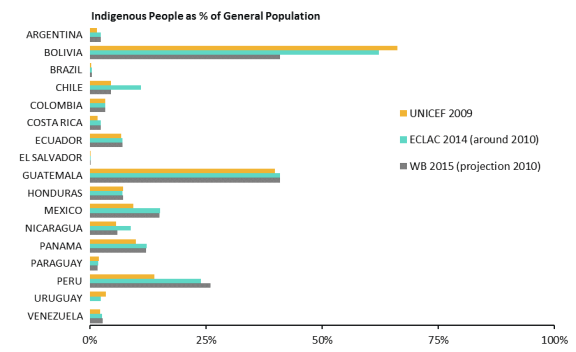 |
Source: Graphic created by CRS using UNICEF and FUNPROEIB Andes
|
Indigenous Groups and Languages
To raise awareness and mobilize action, the U.N. declared 2019 the International Year of Indigenous Languages,9 yet figures on indigenous groups and languages vary among sources.
10 Data on indigenous ethnic groups
” -- World Bank |
11
Figure 3 shows the total number of indigenous groups in Latin America as identified by three sources. A 2009 UNICEF report identified a total of 655 indigenous groups in Latin America.11 12 The 2014 ECLAC report cites 826 indigenous groups in Latin America although it does not provide a country breakdown.1213 Of these 826, about 200 indigenous groups live in voluntary isolation, which is defined by an Inter-American Commission on Human Rights report as groups that "“do not maintain sustained contacts with the majority non-indigenous population."13”14 The World Bank'’s 2015 report identifies 772 indigenous groups in Latin America.14
According to several sources, indigenous languages number fewer than the number of indigenous groups across the region (seeas some languages are spoken by more than one group and some groups have lost their indigenous language (see Figure 4). The 2015 World Bank report found 558 indigenous languages across 20 countries of Latin America,1516 while a 2009 UNICEF report found 551 languages across the same 20 countries.1617 Of these 551, the latter report found that 111 languages are vulnerable to extinction although five (Quechua, Nahuatl, Aymara, Yucatan Maya, and Ki'che'’che’) had over a million speakers each. In 2019, the Summer Institute of Linguistics (SIL International) reported 880 indigenous languages are spoken across the same 20 Latin American countries.18
countries.17
living indigenous languages. Not included are countries, primarily in the Caribbean, whose only indigenous languages are sign languages and Creole languages based on European and African languages.
Table 2 shows a breakdown of Latin America'’s indigenous groups and languages by country according to two sources. CRS created the table from several sources; publication dates and methodologies differed. The countries listed in each table may differ from others in this report based on the information available in the sources.
16 Ibid. This figure excludes six languages in French Guiana. 17 UNICEF, 2009, p. 81. This figure includes six languages in French Guiana. 18 Gary F. Simons (editor), Ethnologue: Languages of the World. Twenty-third edition, SIL International, 2020, at https://www.ethnologue.com/.
Congressional Research Service
8
link to page 14 link to page 14 Indigenous Peoples in Latin America: Statistical Information
Table 2. Indigenous Groups and Languages of Latin America by Country
UNICEF 2009
Indigenous Groups
WB 2015 Indigenous
Country
(languages)a
Groups (languages)b
30
30
Argentina
(15)
(15)
4
4
Belize
(4)
(4)
36
114
Bolivia
(33)
(33)
241
241
Brazil
(186)
(186)
9
9
Chile
(6)
(6)
83
83
Colombia
(65)
(65)
8
8
Costa Rica
(7)
(7)
12
32
Ecuador
(12)
(13)
3
3
El Salvador
(1)
(1)
24
24
Guatemala
(24)
(24)
9
9
Guyana
(9)
(9)
7
7
Honduras
(6)
(6)
67
67
Mexico
(64)
(67)
9
9
Nicaragua
(6)
(6)
8
7
Panama
(8)
(7)
20
20
Paraguay
(20)
(20)
43
52
Peru
(43)
(47)
5
5
Suriname
(5)
(5)
0
0
Uruguay
(0)
(0)
Congressional Research Service
9
link to page 14 link to page 14 link to page 28 link to page 15 Indigenous Peoples in Latin America: Statistical Information
UNICEF 2009
Indigenous Groups
WB 2015 Indigenous
Country
(languages)a
Groups (languages)b
37
50
Venezuela
(37)
(37)
655
774
TOTAL
(551)
(558)
Source: Graphic created by CRS using UNICEF and FUNPROEIB Andes’based on the information available in the sources.
|
Country |
|
|
|
Argentina |
30 (15) |
30 (15) |
|
Belize |
4 (4) |
4 (4) |
|
Bolivia |
36 (33) |
114 (33) |
|
Brazil |
241 (186) |
241 (186) |
|
Chile |
9 (6) |
9 (6) |
|
Colombia |
83 (65) |
83 (65) |
|
Costa Rica |
8 (7) |
8 (7) |
|
Ecuador |
12 (12) |
32 (13) |
|
El Salvador |
3 (1) |
3 (1) |
|
Guatemala |
24 (24) |
24 (24) |
|
Guyana |
9 (9) |
9 (9) |
|
Honduras |
7 (6) |
7 (6) |
|
Mexico |
67 (64) |
67 (67) |
|
Nicaragua |
9 (6) |
9 (6) |
|
Panama |
8 (8) |
7 (7) |
|
Paraguay |
20 (20) |
20 (20) |
|
Peru |
43 (43) |
52 (47) |
|
Suriname |
5 (5) |
5 (5) |
|
Uruguay |
0 (0) |
0 (0) |
|
Venezuela |
37 (37) |
50 (37) |
|
TOTAL |
655 (551) |
774 (558) |
Source: Graphic created by CRS using UNICEF and FUNPROEIB Andes' (UNICEF) 2009 Atlas Sociolingüístico de Pueblos Indígenas en América Latina; and the International Bank for Reconstruction and Development and World Bank'Bank’s (WB) 2015 Indigenous Latin America in the twenty-first century: the first decade.
Notes: This report uses "peoples"“peoples” rather than "tribe," "nation," "“tribe,” “nation,” “ethnic minority,"” or "“sociolinguistic group."
a. ” a. While UNICEF and FUNPROEIB Andes'’ 2009 Atlas covered 25 countries in Latin America and the
Caribbean, Antigua and Barbuda, Dominica, French Guiana, Saint Lucia and Trinidad and Tobago are not otherwise included.
b.
b. While the World Bank'’s 2015 report covered 16 countries in Latin America, French Guiana is not included
in this report.
According to the U.S. Census Bureau, approximately 15,000-19,000 indigenous language speakers from Latin America reside in the United States.18
19
Indigenous languages also relate to issues such as biodiversity. A 2020 study states that “most of the places with the highest concentration of biological diversity coincide with spaces inhabited by indigenous peoples whose members continue to speak the language of their ancestors” and highlights Mexico and Brazil.20 A 2012 study explored “the co-occurrence of linguistic and biological diversity in regions containing many of the Earth’s remaining species…Results indicate that these regions often contain considerable linguistic diversity, accounting for 70% of all languages on Earth.”21 The study specifically notes Mesoamerica as a biodiverse hotspot with more than 250 indigenous languages. Additional resources about indigenous groups and languages can be found inin Table A-1.
Socioeconomic Data
In a 2015 publication, the World Bank found that 43% of indigenous people in Latin America are poor (living on less than $5.50 a day in 2011 purchasing power parity prices or PPP), and 24% are extremely poor (living on less than $1.90 a day in 2011 PPP prices), more than twice the rates for non-indigenous people. The report also documented education gaps were across the region.19 22 Drawing from another World Bank resource, Figure 5 compares rates of indigenous peoples
19 Language is a proxy for Latin American indigenous presence in the United States. See the U.S. Census Bureau, 2006-2008 American Community Survey, “Detailed Language Spoken at Home and Ability to Speak English for the Population 5 Years and Older by States: 2006-2008,” April 2010, at https://www.census.gov/data/tables/2008/demo/2006-2008-lang-tables.html; see also U.S. Census Bureau, 2009-2013 American Community Survey, “Detailed Language Spoken at Home and Ability to Speak English for the Population 5 Years and Over: 2009-2013,” October 2015, at https://www.census.gov/data/tables/2013/demo/2009-2013-lang-tables.html.
20 Claudia Gafner-Rojas, “Indigenous languages as contributors to the preservation of biodiversity and their presence in international environmental law,” Journal of International Wildlife Law & Policy, (June 12, 2020).
21 L. J. Gorenflo, Suzanne Romaine, Russell A. Mittermeier, Kristen Walker-Painemilla, “Co-occurring linguistic and biological diversity,” proceedings of the National Academy of Sciences, Vol. 109, no. 2 (May 2012), pp. 8032-8037.
22 IBRD and World Bank, 2015, pp. 12, 127, 9, 34-37.
Congressional Research Service
10
link to page 16 link to page 16 link to page 17 link to page 17 link to page 18
Indigenous Peoples in Latin America: Statistical Information
compares rates of indigenous peoples living on less than $5.50 a day compared to the general population in select countries of Central and South America.
The World Bank provides statistics on access to various services and opportunities for indigenous peoples in select countries of Central and South America, last updated in October 2018. The following graphs compare indigenous rates of access to these amenities compared with the general population rates by country (Figure 6, electricity;electricity; Figure 7, internet;internet; Figure 8, home home ownership; Figure 9, sewage;sewage; and Figure 10, water).
The World Bank also provides labor and education statistics for indigenous peoples in select countries of Central and South America, last updated in October 2018. The following graphs compare indigenous rates compared with general population rates by country (Figure 11, literacyliteracy; Figure 12, school attendance; Figure 13, unemployment;unemployment; and Figure 14, lowlow-skill and high-skill employment).
Congressional Research Service
14
Indigenous Peoples in Latin America: Statistical Information
employment).
In the appendix
The socioeconomic challenges faced by indigenous peoples also impact their health. In light of COVID-19, the United Nations highlights that “indigenous peoples face limited access to quality and culturally accessible health services, which already affect their health outcomes, such as high
Congressional Research Service
16
link to page 28 Indigenous Peoples in Latin America: Statistical Information
maternal mortality rates and lower life expectancy” and that “the pandemic is compounding the precarious situation.”23 Widespread disease is not new to Latin American indigenous peoples: “While figures for Latin America are unclear, mortality from influenza and H1N1 was between four and seven times higher in indigenous populations…Latin America’s indigenous population was reduced by 95 percent over 300 years through diseases spread by colonizers.”24
In the appendix, Table A-2 lists resources relating to the socioeconomic standing of indigenous peoples in Latin America.
Land and Natural Resources
A 2017 World Resources Institute (WRI) report states "“the precise amount of communal land is not known, but many experts argue that at least half of the world'’s land is held by Indigenous Peoples and other communities. Some estimates are as high as 65 percent or more of the global land area."” The WRI goes on to specify that "“globally, Indigenous Peoples and local communities have formal legal ownership of 10 percent of the land, and have some degree of government-recognized management rights over an additional 8 percent."20
”25
The United Nations'’ Economic Commission for Latin America and the Caribbean'’s (ECLAC) 2014 report Guaranteeing indigenous people'’s rights in Latin America: Progress in the past decade and remaining challenges states that "“over the past decade, booming international demand for primary goods (minerals, hydrocarbons, soybeans and other agricultural commodities) has boosted economic growth in the countries of Latin America but has had its cost in the form of a growing number of environmental, social and ethnic conflicts involving extractive industries located in or near indigenous territories."21
”26
According a 2012 Forest Peoples Programme global report, "“[A]n estimated 350 million people live inside or close to dense forests, largely dependent on these areas for subsistence and income, while an estimated range of 60 million to 200 million indigenous people are almost wholly dependent on forests."22”27 For the region of Mexico, Central and South America, the report estimates 42-48 million indigenous peoples and 21-26 million forest peoples.2328 Some but not all indigenous peoples are also forest peoples. Some countries did not have population figures for forest people.
A 2018 Science article classifies drivers of global tree cover loss using satellite imagery. In Latin America, deforestation accounts for over half of the tree cover loss, shifting agriculture about a third, and, to a smaller degree, forestry, wildfire, and urbanization.24
29
23 UN Inter-Agency Support Group on Indigenous Issues, “Indigenous Peoples and COVID-19 A Guidance Note for the UN System prepared by the UN Inter- Agency Support Group on Indigenous Issues,” April 23, 2020, at https://www.un.org/development/desa/indigenouspeoples/wp-content/uploads/sites/19/2020/04/Indigenous-peoples-and-COVID_IASG_23.04.2020-EN.pdf
24 Martín de Dios, “The situation of Latin America’s indigenous population and the impact of COVID-19,” United Nations Development Programme in Latin America and the Caribbean blog, May 14, 2020, at https://www.latinamerica.undp.org/content/rblac/en/home/blog/2020/impacto-y-situacion-de-la-poblacion-indigena-latinoamericana-ant.html
25 Peter Veit and Katie Reytar, “By the Numbers: Indigenous and Community Land Rights,” World Resources Institute, March 20, 2017, at https://www.wri.org/blog/2017/03/numbers-indigenous-and-community-land-rights.
26 ECLAC, 2014, p. 50. 27 Sophie Chao, Forest Peoples: Numbers across the world, Forest Peoples Programme, p. 7, at http://www.forestpeoples.org/sites/fpp/files/publication/2012/05/forest-peoples-numbers-across-world-final_0.pdf.
28 Ibid., pp. 9-10. 29 Philip G. Curtis, Christy M. Slay, Nancy L. Harris, Alexandra Tyukavina, Matthew C. Hansen, "Classifying drivers
Congressional Research Service
17
Indigenous Peoples in Latin America: Statistical Information
In the 2015 report Indigenous Peoples, Communities of African Descent, Extractive Industries, the IACHR wrote that "“through the implementation of its monitoring mechanisms, the Commission has consistently received information evidencing the human, social, health, cultural and environmental impacts of [extraction, exploitation, and development activities concerning natural resources] on indigenous peoples and Afrodescendent communities. Many extractive and development activities in the hemisphere are implemented in lands and territories historically occupied by indigenous and Afro-descendent communities, which often coincide with areas hosting a great wealth of natural resources."25
Table A-3 lists resources about indigenous peoples' lands and natural resources in Latin America. While the titles may not exclusively focus on indigenous peoples, the industries'”30
Climate Change Indigenous peoples are affected by climate change; they are also responding and adapting to it. According to the International Indigenous Peoples Forum on Climate Change (IIPFCC) established in 2008 as the caucus for indigenous participants in the U.N. Framework Convention on Climate Change processes, indigenous peoples “play a critical role in climate change mitigation and adaptation through their historic and effective role as stewards of much of the world’s remaining forests.”31 The U.N. Special Rapporteur on the Rights of Indigenous Peoples states in a 2018 report that “the rate of tree cover loss is less than half in community and indigenous lands compared to elsewhere. Where community rights to own their lands are legally recognized, the difference is even greater. Worldwide, community lands hold at least a quarter of aboveground tropical forest carbon.”32 A 2017 article cites that 80% of the world’s biodiversity can be found within indigenous territories.33
The 2019 Global Assessment of Biodiversity and Ecosystem Services, produced by the Intergovernmental Science-Policy Platform on Biodiversity and Ecosystem Services (IPBES), was carried out by over 100 experts analyzing over 15,000 scientific publications and a “substantive body of indigenous and local knowledge.”34 Some of the key messages from this report include “Nature is generally declining less rapidly in indigenous peoples’ land than in other lands, but is nevertheless declining, as is the knowledge of how to manage it.”35 The same is said of the decline in biodiversity.36 The report also found that “72 per cent of indicators developed by indigenous peoples and local communities show ongoing deterioration of elements of nature
of global forest loss," Science, Vol. 361, Issue 6407, pp. 1108-1111, September 14, 2018, at https://science.sciencemag.org/content/361/6407/1108. For more information about the Brazilian Amazon, see CRS In Focus IF11306, Fire and Deforestation in the Brazilian Amazon, by Pervaze A. Sheikh et al. For more information about illegal logging around the world, see CRS In Focus IF11114, International Illegal Logging: Background and Issues, by Pervaze A. Sheikh, Lucas F. Bermejo, and Kezee Procita.
30 Inter-American Commission of Human Rights, Indigenous Peoples, Communities of African Descent, Extractive Industries, OEA/Ser.L/V/II, Doc. 47/15, December 31, 2015, at http://www.oas.org/en/iachr/reports/pdfs/ExtractiveIndustries2016.pdf, p. 9.
31 International Indigenous Peoples' Forum on Climate Change, “About the International Indigenous Peoples' Forum on Climate Change,” accessed on January 14, 2020, at https://iipfcc.squarespace.com/who-are-we-1
32 Victoria Tauli-Corpuz, “A Letter from the UN Special Rapporteur on the Rights of Indigenous Peoples” in Cornered by Protected Areas, 2018, at https://www.corneredbypas.com/
33 Linda Etchart, “The role of indigenous peoples in combating climate change,” Palgrave Communications, 3, article no. 17085, (August 22, 2017).
34Intergovernmental Science-Policy Platform on Biodiversity and Ecosystem Services, “Summary for Policy Makers” of the Global Assessment of Biodiversity and Ecosystem Services, 2019, p. 2. Hereinafter IPBES, 2019.
35 IPBES, 2019, p. 14. 36 IPBES, 2019, p. 31.
Congressional Research Service
18
link to page 29 link to page 24 Indigenous Peoples in Latin America: Statistical Information
important to them.”37 The report stresses that the “indigenous and local knowledge systems are locally based, but regionally manifested and thus globally relevant.”38
A 2012 UNESCO publication “provides an overview of the published scientific literature relating to the contribution of traditional/indigenous knowledge to our understanding of global climate change” given that “indigenous knowledge has been widely recognized in fields such as agroforestry, traditional medicine, biodiversity conservation, customary resource management, applied anthropology, impact assessment, and natural disaster preparedness and response.”39
Table A-3 lists resources about indigenous peoples’ lands, natural resources, and climate change in Latin America. While the titles may not exclusively focus on indigenous peoples, the industries’ impact on indigenous people is a part of the analysis of each resource.
impact on indigenous people is a part of the analysis of each resource.
Human Rights and Multilateral Instruments
Various international human rights mechanisms protect the rights of indigenous peoples of Latin America and the Caribbean. Table 3 identifies those countries that have ratified or voted in favor of the following three multilateral instruments on indigenous peoples'’ rights:
-
International Labor Organization
'’s Indigenous and Tribal Peoples Convention, 1989 (No. 169).2640 The convention includes sections on land; recruitment and conditions of employment; vocational training, handicrafts and rural industries; and social security and health; education and means of communication. - United Nations Declaration on the Rights of Indigenous Peoples (UNDRIP).
2741 The 2007 declaration covers such topics as self-determination or autonomy; land and environment; employment; religion; language and media; education; discrimination and violence; and health. - American Declaration on the Rights of Indigenous Peoples (ADRIP).
2842 The 2016 declaration approved by the Organization of American States includes sections on human and collective rights; cultural identity; organizational and political rights; and social, economic and property rights. 37 IPBES, 2019, p. 25. 38 IPBES, 2019, p. 32. 39 Douglas Nakashima, Kirsty Galloway McLean, Hans Thulstrup, Ameyali Ramos Castillo, and Jennifer Rubis, Weathering Uncertainty: Traditional Knowledge for Climate Change Assessment and Adaptation, UNESCO and United Nations University, 2012. 40 International Labor Organization, “Indigenous and Tribal Peoples Convention, 1989 (No. 169),” 1989, at https://www.ilo.org/dyn/normlex/en/f?p=NORMLEXPUB:12100:0::NO::P12100_ILO_CODE:C169. 41 United Nations, “United Nations Declaration on the Rights of Indigenous Peoples,” September 13, 2007, at https://www.un.org/development/desa/indigenouspeoples/wp-content/uploads/sites/19/2018/11/UNDRIP_E_web.pdf. 42 Organization of American States, “American Declaration on the Rights of Indigenous Peoples,” June 15, 2016, at https://www.oas.org/en/sare/documents/DecAmIND.pdf. For more information on the Organization of American States, see CRS Report R42639, Organization of American States: Background and Issues for Congress, by Peter J. Meyer. Congressional Research Service 19 link to page 24 link to page 24 link to page 24 Indigenous Peoples in Latin America: Statistical Information Table 3. Latin America and Multilateral Instruments on Indigenous Peoples’ Rights Voted in favor of Voted in favor of Country Ratified ILO No. 169a adopting UNDRIP adopting ADRIP Argentina X X X Belize -- X X Bolivia X X X Brazil X X X Chile X X X Colombia X Xb Xc Costa Rica X X X Ecuador X X X El Salvador -- X X Guatemala X X X Guyana -- X X Honduras X X X Jamaica -- X X Mexico X X X Nicaragua X X X Panama -- X X Paraguay X X X Peru X X X Suriname -- X X Uruguay -- X X Venezuela X X X Source: Compiled by CRS using the fol owing sources: ILO’s web page “political rights; and social, economic and property rights.
|
Country |
|
Voted in favor of adopting UNDRIP |
Voted in favor of adopting ADRIP |
|
Argentina |
X |
X |
X |
|
Belize |
X |
X |
|
|
Bolivia |
X |
X |
X |
|
Brazil |
X |
X |
X |
|
Chile |
X |
X |
X |
|
Colombia |
X |
|
|
|
Costa Rica |
X |
X |
X |
|
Ecuador |
X |
X |
X |
|
El Salvador |
-- |
X |
X |
|
Guatemala |
X |
X |
X |
|
Guyana |
-- |
X |
X |
|
Honduras |
X |
X |
X |
|
Jamaica |
-- |
X |
X |
|
Mexico |
X |
X |
X |
|
Nicaragua |
X |
X |
X |
|
Panama |
-- |
X |
X |
|
Paraguay |
X |
X |
X |
|
Peru |
X |
X |
X |
|
Suriname |
-- |
X |
X |
|
Uruguay |
-- |
X |
X |
|
Venezuela |
X |
X |
X |
Source: Compiled by CRS using the following sources: ILO's web page "Ratifications of C169 - Indigenous and Tribal Peoples Convention, 1989 (No. 169),"” the U.N. web page "“United Nations Declaration on the Rights of Indigenous People,"” and the OAS'’ official publication of ADRIP.
Notes:
a. International Labor Organization, "“Ratifications of C169 - Indigenous and Tribal Peoples Convention, 1989
(No. 169),"” at https://www.ilo.org/dyn/normlex/en/f?p=1000:11300:0:: NO:11300:P11300_INSTRUMENT_ID:312314.
b. .
b. From the region, only Colombia abstained from the vote. See U.N, Department of Economic and Social
Affairs, "“United Nations Declaration on the Rights of Indigenous People,"” September 13, 2007, at https://www.un.org/development/desa/indigenouspeoples/declaration-on-the-rights-of-indigenous-peoples.html.
c. .
c. In the footnotes, Colombia "“breaks with consensus"” on paragraphs within Articles XXIII, XXIX, and XXX.
See Organization of American States, "“American Declaration on the Rights of Indigenous Peoples,"” June 15, 2016, at https://www.oas.org/en/sare/documents/DecAmIND.pdf.
d. .
d. Cuba is not a voting member. See Organization of American States, "“Member States,"” accessed on April 22,
2019, at http://www.oas.org/en/member_states/default.asp.
.
The United Nations has a Permanent Forum on Indigenous Issues and in 2001 created the Special Rapporteurship on the Rights of Indigenous Peoples, which promote the rights of indigenous
Congressional Research Service
20
link to page 31 link to page 25 link to page 26 Indigenous Peoples in Latin America: Statistical Information
peoples across the globe.43peoples across the globe.29 In 1990, the Organization of American States created the Rapporteurship on the Rights of Indigenous Peoples to promote the rights of indigenous peoples throughout the Western Hemisphere.3044 Table A-4 provides additional resources about the work of international organizations with indigenous peoples.
In a 2000 report, the Inter-American Commission on Human Rights (IACHR) wrote "“concern for the human rights of indigenous peoples and their members has been a constant feature in the work of the Commission."31”45 The IACHR has tracked its work involving indigenous peoples. It hosts multiple sessions per year to hold hearings regarding human rights issues affecting a particular country or subregion of the Western Hemisphere. One of the categories for hearings is the rights of indigenous peoples. Table 4 shows the number of IACHR hearingsevents by country involving indigenous peoples'’ rights. It also shows the number of Inter-American Court of Human Rights legal cases brought by indigenous peoples against countries.
Table 4. Human Rights Hearings and Events and Legal Cases about the Rights of Indigenous
Peoples in the Inter-American System 1996-2020
Country
Events on the Rights
Legal Cases brought
of Indigenous Peoples
by Indigenous Peoples
Colombia
26
2
Peru
20
0
Guatemala
18
2
Ecuador
13
2
Mexico
13
1
Brazil
11
2
Nicaragua
9
2
Chile
9
2
Argentina
8
2
Panama
8
1
Bolivia
8
0
Honduras
7
2
Venezuela
5
1
Costa Rica
4
0
Paraguay
3
2
Belize
2
1
Suriname
1
2
Guyana
1
0
Regionala
33
N/A
43 U.N. Office of the High Commissioner on Human Rights, “Special Rapporteur on the rights of indigenous peoples,” at https://www.ohchr.org/EN/Issues/IPeoples/SRIndigenousPeoples/Pages/SRIPeoplesIndex.aspx.
44 Organization of American States, “Rapporteurship on the Rights of Indigenous Peoples,” at http://www.oas.org/en/iachr/indigenous/.
45 Inter-American Commission on Human Rights, The Human Rights Situation of the Indigenous People in the Americas, OEA/Ser.L/V/II.108, Doc. 62, October 20, 2000, at http://www.cidh.org/Indigenas/TOC.htm.
Congressional Research Service
21
link to page 31 Indigenous Peoples in Latin America: Statistical Information
Source: Table created by CRS using available data from the IACHR from sessions 91-175 (February 1996-March 2020). The first column data comes from the webpage “Hearings by Topic: Rights of Indigenous Peoples” and the second column data comes from the webpage “Hearings by Topic: Petitions and Cases.” Notes: IACHR events include topical hearings, petitions, and precautionary measures, which may or may not be related to a legal case. Legal cases receive an identification number and are counted only once no matter how many events are associated with it. InformationPeoples in the Inter-American System 1996-2019
|
Country |
Hearings on the Rights of Indigenous Peoples |
Cases brought by Indigenous Peoples |
|
Colombia |
25 |
1 |
|
Peru |
20 |
0 |
|
Guatemala |
17 |
5 |
|
Ecuador |
13 |
2 |
|
Mexico |
12 |
2 |
|
Brazil |
11 |
1 |
|
Chile |
9 |
0 |
|
Panama |
8 |
1 |
|
Argentina |
8 |
1 |
|
Bolivia |
8 |
0 |
|
Nicaragua |
8 |
1 |
|
Honduras |
7 |
1 |
|
Venezuela |
4 |
0 |
|
Costa Rica |
4 |
0 |
|
Paraguay |
3 |
2 |
|
Belize |
2 |
0 |
|
Suriname |
1 |
2 |
|
Guyana |
1 |
0 |
|
27 |
N/A |
Source: CRS table created using data from the IACHR's Rapporteurship on the Rights of Indigenous Peoples and reflects sessions 91-172 (February 1996-September 2019).
Notes: Hearings include topical hearings as well as cases, petitions, and precautionary measures. Hearings information is not available for all sessions, particularly before 1996.
a. The IACHR uses this is not available for all sessions, particularly before 1996. a. The IACHR uses the regional category for hearings that span multiple countries. Where countries were
named along with the tag "“regional,"” the hearing was counted for all entities tagged.
In the appendixappendix, Table A-5 lists publications that document various human rights issues confronting indigenous peoples. CRS also publishes a number of reports with country-specific information on indigenous peoples'’ human rights issues.32
Appendix A.
46
46 See CRS Report R43813, Colombia: Background and U.S. Relations, by June S. Beittel; CRS Report R42580, Guatemala: Political and Socioeconomic Conditions and U.S. Relations, by Maureen Taft-Morales; CRS Report R42917, Mexico: Background and U.S. Relations, by Clare Ribando Seelke and Edward Y. Gracia; and CRS Report R44841, Venezuela: Background and U.S. Relations, coordinated by Clare Ribando Seelke.
Congressional Research Service
22
link to page 13 link to page 13 Indigenous Peoples in Latin America: Statistical Information
Appendix A. Data Sources and Resources Lists Data Sources and Resources Lists
The United Nations Children'’s Fund (UNICEF) and Fundación para la Educación en Contextos de Multilingüismo y Pluriculturalidad (the Foundation for Education in Multilingual and Multicultural Contexts or FUNPROEIB) gathered data in 21 Latin American and Caribbean countries in 2009 for its report in two volumes titled Atlas Sociolingüístico de Pueblos Indígenas en América Latina. The report notes the limitations of using national censuses.33
47
In 2014, the United Nations'’ Economic Commission for Latin America and the Caribbean (ECLAC) gathered population data from 17 Latin American countries using national censuses for Guaranteeing Indigenous People'’s Rights in Latin America: Progress in the past Decade and Remaining Challenges. The report notes that most countries ask people to self-identify as indigenous with the exception of Peru, which asks people if they speak an indigenous language.34
48
In 2015, the World Bank gathered data in 16 countries using national censuses and household survey data in order to publish Indigenous Latin America in the Twenty-First Century: the First Decade.3549 The report notes that the definition of who is indigenous has become increasingly controversial and "“underscores the complexity of identifying indigenous people across the region and argues that the conditions of indigeneity vary over time and are, in some cases, context- and country-specific."36
The current”50
The 2020 edition of Ethnologue documents language counts for each country and divides them into indigenous and non-indigenous categories. Indigenous languages figures were used inin Table 2 as non-indigenous is defined as "“a language that did not originate in the country, but which is now established there either as a result of its longstanding presence or because of institutionally supported use and recognition."37”51 Only living languages were included in the count, not languages classified as extinct. Ethnologue's "about"’s “about” section provides details on the methodology, language names, and status of usage.
The World Bank'’s Latin America and Caribbean Equity Lab provides data on poverty, access to services, education and labor (last updated in October 2018). The World Bank notes that ethnic identity is based on self-reported data. Statistics may vary from official statistics reported by governments as the World Bank uses SEDLAC, "“a regional data harmonization effort that increases cross-country comparability."
”
The web page of the Inter-American Commission'’s Human Rights Rapporteurship on the Rights of Indigenous Peoples provides detailed information on hearings and court cases related to indigenous peoples'’ rights.
The data on drivers of forest loss in Latin America are from: Philip G. Curtis, Christy M. Slay, Nancy L. Harris, Alexandra Tyukavina, Matthew C. Hansen, "Classifying drivers of global forest loss," Science, Vol. 361, Issue 6407, pp. 1108-1111, September 14, 2018, at https://science.sciencemag.org/content/361/6407/1108. There are multiple methodologies for each driver of forest loss using map-based estimates and sample-based estimates.
47 UNICEF, 2009. pp. vii-ix. 48 ECLAC, 2014, pp. 34-36. 49 IBRD and World Bank, 2015, pp. 6, 9. 50 Ibid. 51 Gary F. Simons (editor), “Language Information,” Ethnologue: Languages of the World. Twenty-third edition, SIL International, 2020, at https://www.ethnologue.com/about/language-info. Congressional Research Service 23 Indigenous Peoples in Latin America: Statistical Information For each table below, sources are listed in reverse chronological order with the year in parentheses following the title. Multiple sources from the same year are listed alphabetically as are sources without a publication date, such as websites. Some sources are global, with a section dedicated to Latin America.
Table A-1. Resources on Indigenous Languages in Latin America
Title
Author
Resource Type
URL
Languages of the World,
Gary F. Simons (editor),
World language
http://www.ethnologue.co
Twenty-third edition
Ethnologue
encyclopedia with maps
m
(2020)
Celebrating Indigenous
Google Earth
Interactive website
https://earth.google.com/
Languages (2019)
web/data=CiQSIhIgYTY1Y2U1NTk3MzE4MTFlOTkzN2RjN2JkNTNhNDc1ZGI
International Year of
United Nations
Website with map,
https://en.iyil2019.org/
Indigenous Languages
summary report and
(2019)
more
Atlas Sociolingüístico de
UNICEF and FUNPROEIB Report in Spanish only
https://www.unicef.org/ho
Pueblos Indígenas en
Andes
nduras/tomo_1_atlas.pdf;
América Latina,
https://www.unicef.org/ho
Volúmenes I and II (2009)
nduras/tomo_2_atlas.pdf
Table A-1. Resources on Indigenous Languages in Latin America
|
Title |
Author |
Resource Type |
URL |
|
Celebrating Indigenous Languages (2019) |
Google Earth |
Interactive website |
https://earth.google.com/web/data=CiQSIhIgYTY1Y2U1NTk3MzE4MTFlOTkzN2RjN2JkNTNhNDc1ZGI |
|
International Year of Indigenous Languages (2019) |
United Nations |
Website |
|
|
Languages of the World, Twenty-second edition (2019) |
David M. Eberhard, Gary F. Simons, and Charles D. Fenning (editors), Ethnologue |
Language encyclopedia |
|
|
Atlas Sociolingüístico de Pueblos Indígenas en América Latina, Volúmenes I and II (2009) |
UNICEF and FUNPROEIB Andes |
Report in Spanish |
https://www.unicef.org/honduras/tomo_1_atlas.pdf; https://www.unicef.org/honduras/tomo_2_atlas.pdf |
Source: Compiled by CRS.
Source: Compiled by CRS.
Table A-2. Resources on Indigenous Socioeconomics
Title
Author
Resource Type
URL
Linking Indigenous
Organization for
Report on OECD
https://www.oecd-
Communities with
Economic Cooperation
member countries
ilibrary.org/urban-rural-
Regional Development
and Development
including Chile and
and-regional-
(2019)
Mexico with some
development/linking-
information on non-
indigenous-communities-
member countries
Table A-2. Resources on Indigenous Socioeconomics
|
Title |
Author |
Resource Type |
URL |
|
Linking Indigenous Communities with Regional Development (2019) |
Organization for Economic Cooperation and Development |
Report on OECD member countries including Chile and Mexico with some information on non-member countries |
|
|
State of the world`s indigenous peoples: Education, 3rd volume (2017) |
United Nations |
Report |
|
|
Indigenous Latin America in the twenty-first century: the first decade (2015) |
International Bank for Reconstruction and Development and the World Bank |
Report |
|
The state of the world´s
United Nations
Report with a chapter on
https://www.un.org/esa/so
indigenous people:
Latin America and the
cdev/unpfi /documents/20
Indigenous people´s
Caribbean
16/Docs-
access to health services,
updates/SOWIP_Health.p
2nd volume (2015)
df
Congressional Research Service
24
Indigenous Peoples in Latin America: Statistical Information
Title
Author
Resource Type
URL
Indigenous Peoples
U.S. Agency for
Website with policy, blog,
https://www.usaid.gov/indi
International
and more
genous-peoples
Development
LAC Equity Lab: A
World Bank
Regional economic data
http://www.worldbank.or
Platform for Poverty and
and maps
g/en/topic/poverty/lac-
Inequality Analysis
equity-lab1
|
United Nations |
Report |
|
|
LAC Equity Lab: A Platform for Poverty and Inequality Analysis |
World Bank |
Regional economic data and maps |
Source: Compiled by CRS.
Source: Compiled by CRS.
Table A-3. Resources on Indigenous Land and, Natural Resources, and Climate Change in
Latin America
Title
Author
Resource Type
URL
Environmental
World Justice Project
Report
https://worldjusticeprojec
Governance in Latin
t.org/our-work/research-
America (expected spring
and-data/special-
2020, appears to be
reports/environmental-
delayed)
governance-latin-america
Authorized to Steal:
Center for International
Report covers
https://www.ciel.org/wp-
Organized Crime
Environmental Law
government oversight,
content/uploads/2019/07/
Networks Launder Il egal
laundering, supply chains
Authorized-to-Steal-July-
Timber from the Peruvian
and recommendations
2019.pdf
Amazon (2019)
Blood Gold in the
Jon Lee Anderson, The
Long article
https://www.newyorker.c
Brazilian Rain Forest
New Yorker
om Natural Resources in Latin America
|
Title |
Author |
Resource Type |
URL |
|
Blood Gold in the Brazilian Rain Forest (2019) |
Jon Lee Anderson, The New Yorker |
Long article |
|
|
Rainforest Mafias: How Violence and Impunity Fuel Deforestation in Brazil's Amazon (2019) |
Human Rights Watch |
Report |
|
|
Situation of Human Rights of the Indigenous and Tribal Peoples of the Pan-Amazon Region (2019) |
Inter-American Commission on Human Rights |
Report |
http://www.oas.org/en/iachr/reports/pdfs/Panamazonia2019-en.pdf |
|
Looted Amazon (2018) |
Infoamazonia and Amazon Georeferenced Socio-Environmental Information Network |
Report |
|
|
Organized Crime and Illegally Mined Gold in Latin America (2016) |
Global Initiative against Transnational Organized Crime |
Report |
https://globalinitiative.net/organized-crime-and-illegally-mined-gold-in-latin-america/ |
|
Amazonía Socioambiental |
Amazon Geo-Referenced Socio-Environmental Information Network, a consortium of civil society organizations from several countries |
Maps and publications (English, Spanish, Portuguese) |
|
|
Environmental Justice Atlas |
Autonomous University of Barcelona's Institute of Environmental Science and Technology |
| |
|
Indigenous peoples and food security in Latin America and the Caribbean |
FAO Regional Office for Latin America and the Caribbean |
Website |
http://www.fao.org/americas/prioridades/pueblos-indigenas/en/ |
|
Authorized to Steal: Organized Crime Networks Launder Illegal Timber from the Peruvian Amazon (2019) |
Center for International Environmental Law |
Report |
https://www.ciel.org/wp-content/uploads/2019/07/Authorized-to-Steal-July-2019.pdf |
|
Landmark Map |
World Resources Institute, International Land Coalition and others |
Maps, data, country profiles |
Source: Compiled by CRS.
|
Title |
Author |
Resource Type |
URL |
|
United Nations |
Report |
|
|
Indigenous Peoples and Local Communities Portal |
World Intellectual Property Organization |
Website provides access to publications and events |
|
|
Indigenous Peoples—OAS |
Organization of American States |
| |
|
Indigenous and tribal peoples |
International Labor Organization |
Website provides access to projects, publications and supervision of conventions |
https://www.ilo.org/global/topics/indigenous-tribal/lang--en/index.htm |
|
United Nations for Indigenous Peoples |
United Nations' Department of Economic and Social Affairs |
|
Source: Compiled by CRS.
Source: Compiled by CRS.
Table A-5. Resources on Indigenous Peoples'’ Human Rights in Latin America
Title
Author
Resource Type
URL
Front Line Defenders
Front Line Defenders
Report about physical,
https://www.frontlinedefe
Global Analysis 2019
digital, legal and social
nders.org/sites/default/file
(2020)
attacks against human
s/global_analysis_2019_w
rights defenders
eb.pdf
Human Rights in the
Amnesty International
Report with subsection
https://www.amnesty.org/
Americas Annual Report
on indigenous peoples for
en/documents/amr01/135
2019 (2020)
each country
3/2020/en/
Indigenous World 2020
International Work
Annual reports from
https://www.iwgia.org/en/
Group for Indigenous
1986-2020 about
resources/indigenous-
Affairs
developments affecting
world
indigenous peoples, organized by country
Congressional Research Service
27
Indigenous Peoples in Latin America: Statistical Information
Title
Author
Resource Type
URL
Indigenous Navigator
Community-generated
Website and database
http://nav.indigenousnavig
(2018)
data, website supported
ator.com/
by the European Union
Indigenous Women and
Inter-American
Report with hearings,
http://www.oas.org/en/iac
Their Human Rights in
Commission on Human
cases, thematic and
hr/reports/pdfs/Indigenou
the Americas (2017)
Rights
country reports that
sWomen.pdf
Human Rights in Latin America
|
Title |
Author |
Resource Type |
URL |
|
Front Line Defenders Global Analysis 2019 (2020) |
Front Line Defenders |
Report about physical, digital, legal and social attacks against human rights defenders |
https://www.frontlinedefenders.org/sites/default/files/global_analysis_2019_web.pdf |
|
Indigenous Navigator (2018) |
Community-generated data, website supported by the European Union |
Website and database |
|
|
Indigenous Women and Their Human Rights in the Americas (2017) |
Inter-American Commission on Human Rights |
|
http://www.oas.org/en/iachr/reports/pdfs/IndigenousWomen.pdf |
|
Guaranteeing indigenous people's rights in Latin America: Progress in the past decade and remaining challenges (2014) |
Economic Commission for Latin America and the Caribbean |
Report |
https://repositorio.cepal.org/bitstream/handle/11362/37051/4/S1420782_en.pdf |
|
Captive Communities: Situation of the Guaraní Indigenous People and Contemporary Forms of Slavery in the Bolivian Chaco (2009) |
Inter-American Commission on Human Rights |
Report with background information and state legislation and initiatives |
https://www.oas.org/en/iachr/indigenous/docs/pdf/CAPTIVECOMMUNITIES.pdf |
|
Country Reports on Human Rights Practices |
U.S. State Department |
Annual report with chapters about each country with section "Discrimination, Societal Abuses, and Trafficking in Persons" that includes indigenous peoples |
|
|
Indigenous World |
International Work Group for Indigenous Affairs |
Annual report about developments affecting indigenous peoples with chapters about each country |
Source: Compiled by CRS.
Appendix B.
National Agencies of Indigenous Affairs
|
Country |
Agency (parent agency, office) |
Website |
|
Argentina |
Secretaría de Derechos Humanos, Instituto Nacional de Asuntos Indígenas |
|
|
Bolivia |
Ministerio de Culturas y Turismo, Viceministro de Interculturalidad & Viceministro de Descolonización |
http://www.minculturas.gob.bo/es/articulo/336-viceministro-de-interculturalidad http://www.minculturas.gob.bo/es/articulo/17-viceministro-de-descolonizacin |
|
Brazil |
| |
|
Chile |
Ministerio de Desarrollo Social, Corporación Nacional de Desarrollo Indígena |
|
|
Colombia |
|
https://www.mininterior.gov.co/mision/direccion-de-asuntos-indigenas-rom-y-minorias |
|
Costa Rica |
Comisión Nacional de Asuntos Indígenas |
|
|
Ecuador |
Consejo Nacional para la Igualdad de Pueblos y Nacionalidades |
|
|
El Salvador |
Ministerio de Cultura, Departamento de Pueblos Indígenas |
http://www.cultura.gob.sv/departamento-de-pueblos-indigenas/ |
|
Guatemala |
Ministerio Público, Secretaría de Pueblos Indígenas |
|
|
Guyana |
Ministry of Indigenous Peoples' Affairs |
|
|
Honduras |
| |
|
Mexico |
| |
|
Nicaragua |
|
http://legislacion.asamblea.gob.ni/Tablas%20Generales.nsf/InfoComision.xsp |
|
Panama |
Ministerio de Gobierno y Justicia, Viceministerio de Asuntos Indígenas; Ministerio de Salud, Dirección de Asuntos Sanitarios Indígenas |
http://www.mingob.gob.pa/viceministerio-asuntos-indigenas/ http://www.minsa.gob.pa/direccion/direccion-de-asuntos-sanitarios-indigenas |
|
Paraguay |
Presidencia de la República, Instituto Paraguayo del Indígena |
|
|
Peru |
Ministerio de Cultura, Viceministerio de Interculturalidad, Dirección de Políticas indígenas |
http://cultura.gob.pe/es/interculturalidad/politicasindigenas |
|
Uruguay |
Ministerio del Interior, Área Étnico Racial |
|
|
Venezuela |
Ministerio del Poder Popular para los Pueblos Indígenas |
http://www.minpi.gob.ve/
los Pueblos Indígenas
Source: Compiled by CRS.
Author Information
Carla Y. Davis-Castro
Research Librarian
Disclaimer
This document was prepared by the Congressional Research Service (CRS). CRS serves as nonpartisan shared staff to congressional committees and Members of Congress. It operates solely at the behest of and under the direction of Congress. Information in a CRS Report should not be relied upon for purposes other than public understanding of information that has been provided by CRS to Members of Congress in connection with CRS’s institutional role. CRS Reports, as a work of the United States Government, are not subject to copyright protection in the United States. Any CRS Report may be reproduced and distributed in its entirety without permission from CRS. However, as a CRS Report may include copyrighted images or material from a third party, you may need to obtain the permission of the copyright holder if you wish to copy or otherwise use copyrighted material.
Congressional Research Service
R46225 · VERSION 3 · UPDATED
30 Source: Compiled by CRS.
Author Contact Information
Footnotes
| 1. |
For example, see the following hearings that have touched on issued related to indigenous peoples: U.S. Congress, Senate Committee on Foreign Relations, Subcommittee on Western Hemisphere, Peace Corps, Narcotics and Terrorism, Environmental Protection in an Era of Dramatic Economic Growth in Latin America, 106th Cong., 2nd sess., July 25, 2000 (Washington, DC: GPO, 2000); U.S. Congress, House Committee on Foreign Affairs, Subcommittee on the Western Hemisphere, U.S.–Mexico Security Cooperation: An Overview of the Merida Initiative 2008–Present, 113th Cong., 1st sess., May 23, 2013 (Washington, DC: GPO, 2013); U.S. Congress, House Committee on Foreign Affairs, Subcommittee on the Western Hemisphere, Energy Opportunities in South America, 115th Cong., 1st sess., May 17, 2017 (Washington, DC: GPO, 2017). |
| 2. |
U.N. Department of Economic and Social Affairs, "Indigenous Peoples at the UN," at https://www.un.org/development/desa/indigenouspeoples/about-us.html. |
| 3. |
United Nations, The United Nations Declaration on the Rights of Indigenous Peoples: A Manual for National Human Rights Institutions, HR/PUB/13/2, 2013, at https://www.ohchr.org/Documents/Issues/IPeoples/UNDRIPManualForNHRIs.pdf. For more information about the United Nations, the International Labor Organization and the World Intellectual Property Organization, see CRS Report R43614, Membership in the United Nations and Its Specialized Agencies, by Luisa Blanchfield and Marjorie Ann Browne. |
| 4. |
United Nations, The state of the world´s indigenous people: Implementing the United Nations Declaration on the Rights of Indigenous Peoples, 4th volume, ST/ESA/371, 2019, at https://social.un.org/unpfii/sowip-vol4-web.pdf. |
| 5. |
In this report, Latin America includes Mexico, the land mass of Central America (Belize, Guatemala, El Salvador, Honduras, Nicaragua, Costa Rica and Panama), and the land mass of South America (Colombia, Venezuela, Guyana, Suriname, Brazil, Ecuador, Peru, Bolivia, Chile, Argentina, Paraguay, and Uruguay). The exception is French Guiana, which is an overseas department of France and is not included in this report. |
| 6. |
International Bank for Reconstruction and Development/World Bank, Indigenous Latin America in the Twenty-First Century: the First Decade, 2015, pp. 6, 9, at http://documents.worldbank.org/curated/en/2016/02/24863854/indigenous-latin-america-twenty-first-century-first-decade, p. 24. Hereinafter: World Bank, 2015. |
| 7. |
Economic Commission for Latin America and the Caribbean, Guaranteeing indigenous people's rights in Latin America: Progress in the past decade and remaining challenges, November 2014, p. 40, at https://repositorio.cepal.org/bitstream/handle/11362/37051/4/S1420782_en.pdf. Hereinafter: ECLAC, 2014. |
| 8. |
World Bank, 2015, p. 10. |
| 9. |
United Nations, "International Year of Indigenous Languages," at https://en.iyil2019.org/. |
| 10. |
IBRD and World Bank, 2015, p. 24. |
| 11. |
UNICEF and FUNPROEIB Andes, Atlas Sociolingüístico de Pueblos Indígenas en América Latina Vol. I, 2009, p. 68, at https://www.unicef.org/honduras/tomo_1_atlas.pdf. Hereinafter, UNICEF, 2009. This figures excludes 10 indigenous groups from Antigua and Barbuda, Dominica, French Guiana, Saint Lucia and Trinidad and Tobago, which are not otherwise included in the report. |
| 12. |
ECLAC, 2014, pp. 38-39. |
| 13. |
Rapporteurship on the Rights of Indigenous Peoples, Indigenous peoples in voluntary isolation and initial contact in the Americas: Recommendations for the full respect of their human rights, Inter-American Commission on Human Rights, OEA/Ser.L/V/II. Doc.47/13, 2013, p. 4, at http://www.oas.org/en/iachr/indigenous/docs/pdf/report-indigenous-peoples-voluntary-isolation.pdf. |
| 14. |
IBRD and World Bank, 2015, p. 26. This figure excludes six indigenous groups from French Guiana. |
| 15. |
Ibid. This figure excludes six languages in French Guiana. |
| 16. |
UNICEF, 2009, p. 81. This figure includes six languages in French Guiana. |
| 17. |
David M. Eberhard, Gary F. Simons, and Charles D. Fenning (editors), Ethnologue: Languages of the World. Twenty-second edition, SIL International, 2019, at https://www.ethnologue.com/. |
| 18. |
Language is a proxy for Latin American indigenous presence in the United States. See the U.S. Census Bureau, 2006-2008 American Community Survey, "Detailed Language Spoken at Home and Ability to Speak English for the Population 5 Years and Older by States: 2006-2008," April 2010, at https://www.census.gov/data/tables/2008/demo/2006-2008-lang-tables.html; see also U.S. Census Bureau, 2009-2013 American Community Survey, "Detailed Language Spoken at Home and Ability to Speak English for the Population 5 Years and Over: 2009-2013," October 2015, at https://www.census.gov/data/tables/2013/demo/2009-2013-lang-tables.html. |
| 19. |
IBRD and World Bank, 2015, pp. 12, 127, 9, 34-37. |
| 20. |
Peter Veit and Katie Reytar, "By the Numbers: Indigenous and Community Land Rights," World Resources Institute, March 20, 2017, at https://www.wri.org/blog/2017/03/numbers-indigenous-and-community-land-rights. |
| 21. |
ECLAC, 2014, p. 50. |
| 22. |
Sophie Chao, Forest Peoples: Numbers across the world, Forest Peoples Programme, p. 7, at http://www.forestpeoples.org/sites/fpp/files/publication/2012/05/forest-peoples-numbers-across-world-final_0.pdf. |
| 23. |
Ibid., pp. 9-10. |
| 24. |
Philip G. Curtis, Christy M. Slay, Nancy L. Harris, Alexandra Tyukavina, Matthew C. Hansen, "Classifying drivers of global forest loss," Science, Vol. 361, Issue 6407, pp. 1108-1111, September 14, 2018, at https://science.sciencemag.org/content/361/6407/1108. For more information about the Brazilian Amazon, see CRS In Focus IF11306, Fire and Deforestation in the Brazilian Amazon, by Pervaze A. Sheikh et al. For more information about illegal logging around the world, see CRS In Focus IF11114, International Illegal Logging: Background and Issues, by Pervaze A. Sheikh, Lucas F. Bermejo, and Kezee Procita. |
| 25. |
Inter-American Commission of Human Rights, Indigenous Peoples, Communities of African Descent, Extractive Industries, OEA/Ser.L/V/II, Doc. 47/15, December 31, 2015, at http://www.oas.org/en/iachr/reports/pdfs/ExtractiveIndustries2016.pdf, p. 9. |
| 26. |
International Labor Organization, "Indigenous and Tribal Peoples Convention, 1989 (No. 169)," 1989, at https://www.ilo.org/dyn/normlex/en/f?p=NORMLEXPUB:12100:0::NO::P12100_ILO_CODE:C169. |
| 27. |
United Nations, "United Nations Declaration on the Rights of Indigenous Peoples," September 13, 2007, at https://www.un.org/development/desa/indigenouspeoples/wp-content/uploads/sites/19/2018/11/UNDRIP_E_web.pdf. |
| 28. |
Organization of American States, "American Declaration on the Rights of Indigenous Peoples," June 15, 2016, at https://www.oas.org/en/sare/documents/DecAmIND.pdf. For more information on the Organization of American States, see CRS Report R42639, Organization of American States: Background and Issues for Congress, by Peter J. Meyer. |
| 29. |
U.N. Office of the High Commissioner on Human Rights, "Special Rapporteur on the rights of indigenous peoples," at https://www.ohchr.org/EN/Issues/IPeoples/SRIndigenousPeoples/Pages/SRIPeoplesIndex.aspx. |
| 30. |
Organization of American States, "Rapporteurship on the Rights of Indigenous Peoples," at http://www.oas.org/en/iachr/indigenous/. |
| 31. |
Inter-American Commission on Human Rights, The Human Rights Situation of the Indigenous People in the Americas, OEA/Ser.L/V/II.108, Doc. 62, October 20, 2000, at http://www.cidh.org/Indigenas/TOC.htm. |
| 32. |
See CRS Report R43813, Colombia: Background and U.S. Relations, by June S. Beittel; CRS Report R42580, Guatemala: Political and Socioeconomic Conditions and U.S. Relations, by Maureen Taft-Morales; CRS Report R42917, Mexico: Background and U.S. Relations, by Clare Ribando Seelke and Edward Y. Gracia; and CRS Report R44841, Venezuela: Background and U.S. Relations, coordinated by Clare Ribando Seelke. |
| 33. |
UNICEF, 2009. pp. vii-ix. |
| 34. |
ECLAC, 2014, pp. 34-36. |
| 35. |
IBRD and World Bank, 2015, pp. 6, 9. |
| 36. |
Ibid. |
| 37. |
David M. Eberhard, Gary F. Simons, and Charles D. Fenning (editors), "Language Information," Ethnologue: Languages of the World. Twenty-second edition, SIL International, 2019, at https://www.ethnologue.com/about/language-info. |



